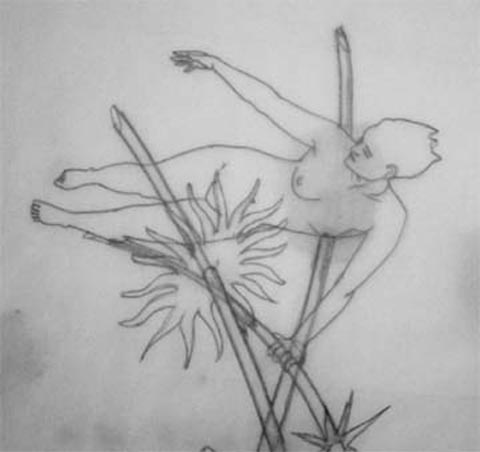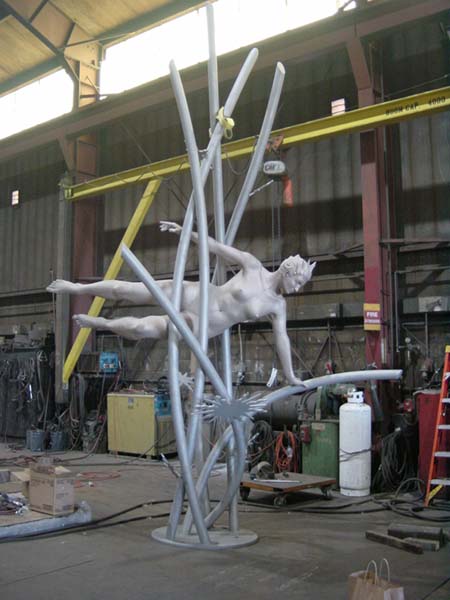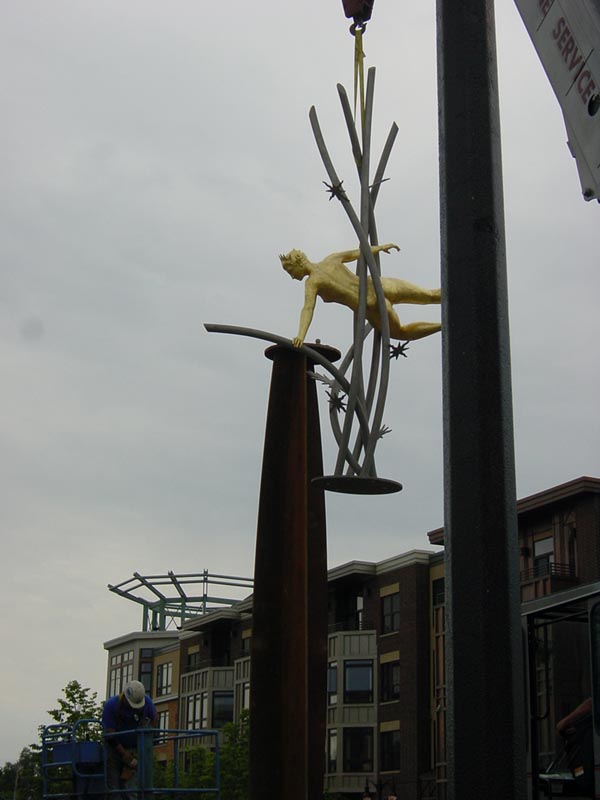How They Do It: Public Sculptors Myklebust and Sears
Amanda Vail, local arts writer and studio assistant to the sculpture partnership Andrea Myklebust and Stan Sears, describes some of the ways in which public sculpture gets made. Resources for artists follow.




Like most people, I walk past art every day: outdoor sculptures, architectural facades, benches, murals and more. Also like most people, I gave no thought to how these works came to be until I was in the middle of that process. During the summer of 2002, I was offered a job carving Indiana limestone for Myklebust-Sears, a public design team composed of spouses Andrea Myklebust and Stanton Sears. By the end of the summer we had all figured out that I’m much better at office jobs than I am at carving stone, and so it was that I gained not only a first-hand look at the process of public art, but the chance to participate in it as well.
Unlike the majority of artwork, public art remains a concept until there is funding for it. As unromantic as it is, money remains the enabling factor for the creation of art on a public scale. As more and more organizations become aware of the benefits of art in society’s spaces, more and more money is being set aside for such a purpose. Most states and many cities now have what is called a “Percent for Art” program. Under this sort of program, one percent of the construction budget for any newly constructed or renovated government-funded building is set aside for the purchase of art. Probably seventy-five percent of the major projects done by Myklebust-Sears are completed under these programs.
Once the funding exists, the next step is finding the artists and the artwork. To this end there is a very strong network in place of funders, artists, galleries, and art consultants. Galleries and art consultants are largely used for the purchase of preexisting artwork. To commission artwork, a series of R.F.Q’s (“Requests for Qualifications”) and R.F.P’s (“Requests for Proposals”) are sent to various magazines and arts organizations with the purpose of soliciting responses from artists. It is up to the artist to subscribe to the magazines and mailing lists and otherwise remain abreast of the current projects in their area of expertise.
Incidentally, this is my job. I sort through the hundreds of projects available and choose which are the best to reply to. For the most part I send off R.F.Q’s; Myklebust and Sears have too much on their plates to spend time designing projects which may only have a one-in-fifty chance of making it past the drawing table. During the early stages of their business, when they were only completing one or two projects per year, R.F.P’s were more practical. Now, however, with seven to twelve projects going at any one time, they need to concentrate on efficiency. Their effort in the past has enabled their artwork to speak for them, testifying to project committees about the manner in which they work rather than a single idea for a single location.
Perhaps only one-tenth of the R.F.Q’s that Myklebust-Sears send out get a positive response. Generally, this reply requests a site-specific proposal to be compared with proposals from a few other artists – Myklebust-Sears is “short-listed.” A small design fee for each of the short-listed artists is usually included in the project’s overall budget, as is a travel fund to enable the out-of-state artists to visit the site and present their proposals to the committee. If all goes well and they win the commission, a contract is drawn up and signed and Myklebust and Sears are finally able to bring their ideas to life.
Which makes it sound much simpler than it really is. Project timelines can be anywhere from six months to four years or more. A lot can happen during this time to change the nature of the final artwork. The biggest thing to remember is that the public artist is creating the work not, in the end, for him or herself but for a much larger, much more complex group: the people who own and who use the site. Myklebust’s and Sears’ needs as artists are ultimately sublimated to the wants and needs of the committee. Everyone gets a say in their art and sometimes their own say is not the largest chunk. In many ways, making the work itself is actually the easiest part. (Which is not to say that it is easy by any means – four months in a plastic tent covered in limestone dust with an aching back is enough to convince me otherwise.)
Tiring negotiations and idiotic committee members aside, it is just these challenges which keep Myklebust and Sears going. Although I do not believe either one of them has ever come right out and said it, I have seen how the challenge of meeting both their own expectations and the expectations of the public keeps them alive. I would like to think that in serving more than just their own interests, Myklebust and Sears have occasionally brought forth some glimmer of the nature of their society. I may be a hopeless romantic at heart, but I know that walking Nicollet Mall on a Thursday morning in the summer, sitting next to a stranger on a granite bench shaped like a boat, is one of my most beatific experiences.
Resources for Sculptors
Listed here are a few of the resources available to artists seeking a start in public art. As always, one of the best ideas is to get in contact with one of the local arts agencies, such as Forecast, which often receive information about RFQ’s which they may be willing to forward. Mary Altman, of the Minnesota State Arts Board, keeps an email list of artists to which she sends any pertinent emails she gets. Simply searching for “Percent for Art Program” or “State Arts Board” on the Internet will turn up a list of organizations across the country that either immediately accept or take applications for their mailing lists. This said, here are a few other options:
Sculpture magazine often prints public art opportunities in their insert section, although you must be a member of the ISC to get the insert. Newsstand copies do not contain it. See the magazine for membership and subscription information, or go to www.sculpture.org.
a-n Magazine is a good resource for opportunities in Great Britain.
The Public Art Network is a good place to check out. One can find information on it at the Americans for the Arts website: www.americansforthearts.org
Art Calendar magazine presents many opportunities. Check it out at www.artcalendar.com
Notes on the Featured Projects
“Allegory of Excelsior”
Sited one block north of Excelsior Blvd. in the heart of Saint Louis Park’s new downtown green. The initial design work, after Myklebust had already been accepted for the project, began in late 2001. Some of the sentiment for the piece, although not visible anywhere in the design of the final sculpture, arose from the occurrences on September 11th. Further design work and fabrication continued throughout 2002 and into 2003; the project was installed in June of 2003 after about two years, which is a usual time for such pieces. The budget was approximately $175,000.00.
“Net, Shoe, Glove, Ball, Ball Ball.”
Installed by Sears in early 2004 on the grounds of the Community Board Center of the Rochester Community and Technical College. The budget was approximately $64,000.00.